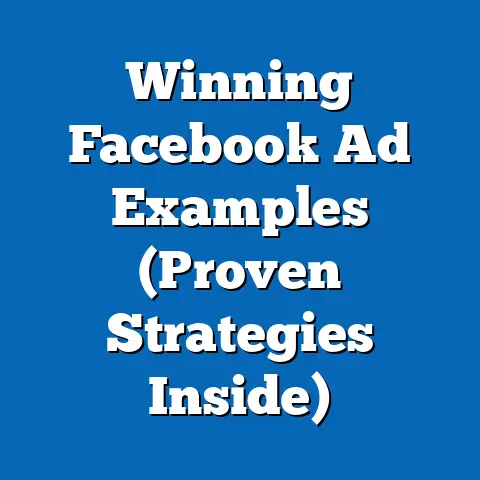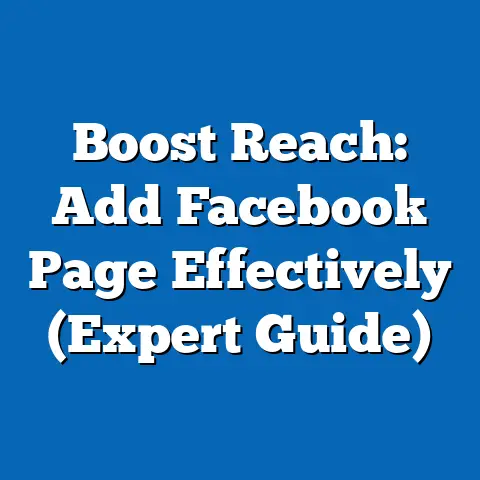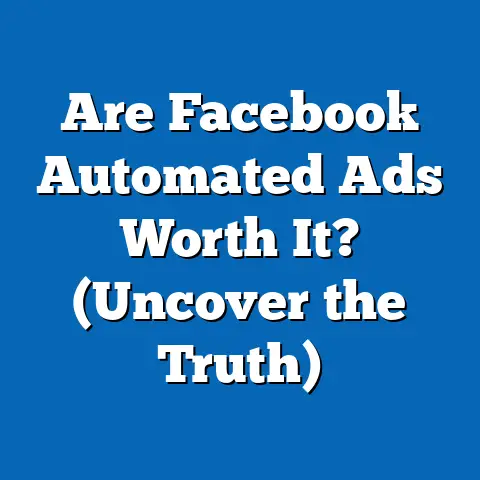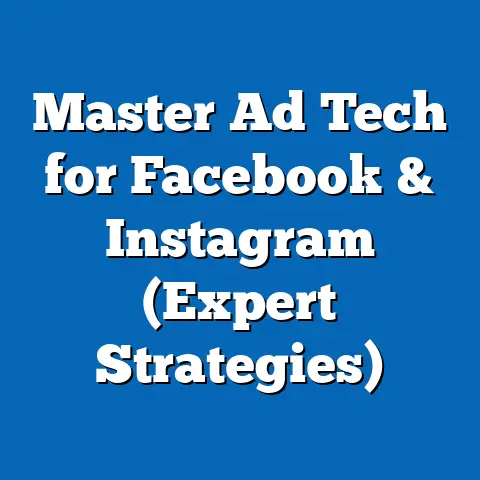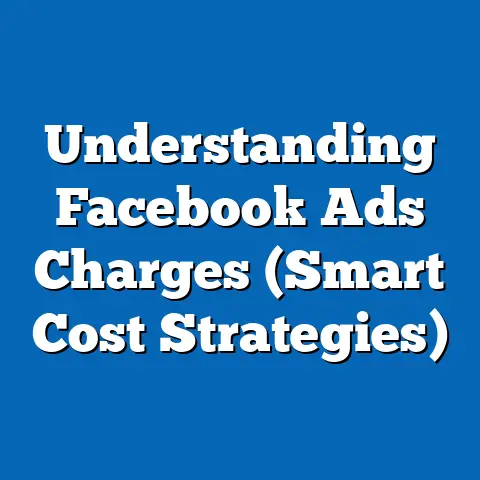Maximize fb ad Reach: Unlock Minimum Audience Size (Expert Tips)
Have you ever felt like you’re shouting into a void with your Facebook ads? You meticulously craft your message, design stunning visuals, and carefully select your target audience, only to be met with disappointing results. The truth is, reaching the right audience on Facebook isn’t just about casting the widest net possible. It’s about strategic targeting, understanding the nuances of audience size, and crafting compelling content that resonates with the people you’re trying to reach.
I’ve spent years navigating the ever-changing landscape of Facebook advertising, and I’ve seen firsthand how easily businesses can fall into the trap of thinking “bigger is better” when it comes to audience size. They chase massive numbers, hoping to increase their reach and visibility, but often end up wasting their budget on irrelevant clicks and impressions.
Think of it like this: imagine you’re trying to sell high-end hiking boots. Would you rather advertise to a million people who are vaguely interested in the outdoors, or to a smaller, more targeted audience of avid hikers who are actively searching for new gear? The answer is obvious.
In this article, I’m going to share my expert tips on how to maximize your Facebook ad reach by focusing on what I call “waterproof options.” These are strategies that ensure your ads maintain effectiveness and relevance across different audience sizes and characteristics. We’ll dive into the importance of audience size, explore the various targeting options available on Facebook, and uncover the secrets to crafting compelling ads that resonate with smaller, more targeted audiences. By the end of this guide, you’ll have the knowledge and tools you need to unlock the true potential of your Facebook ad campaigns and achieve meaningful results.
Section 1: Understanding Facebook Audience Targeting
Facebook audience targeting is the cornerstone of any successful advertising campaign on the platform. It’s the process of selecting specific groups of people to show your ads to, based on their demographics, interests, behaviors, and other characteristics. Think of it as the GPS system for your ad budget, guiding your message to the individuals who are most likely to be interested in what you have to offer.
Why is this so important? Because in today’s crowded digital landscape, simply throwing money at a large, untargeted audience is a recipe for disaster. You’ll end up wasting your budget on people who are unlikely to convert, and your message will get lost in the noise.
Facebook offers a wide range of targeting options, each with its own unique strengths and applications. Let’s break them down:
- Demographics: This is the most basic level of targeting, allowing you to reach people based on age, gender, location, education, job title, relationship status, and more. It’s a great starting point for defining your target audience, but it’s often not enough on its own.
- Interests: This option allows you to target people based on their expressed interests, hobbies, and passions. Facebook gathers this information from the pages they like, the groups they join, and the content they interact with on the platform. For example, if you’re selling fitness equipment, you could target people who are interested in “yoga,” “running,” or “weightlifting.”
- Behaviors: This targeting option allows you to reach people based on their past behaviors, such as purchase history, device usage, travel habits, and more. This can be incredibly powerful for reaching people who are actively looking for products or services like yours. For example, you could target people who have recently purchased items online or who have traveled to a specific destination.
- Custom Audiences: This is where things get really interesting. Custom Audiences allow you to upload your own customer data (such as email addresses, phone numbers, or website visitors) and create targeted audiences on Facebook. This is a fantastic way to re-engage existing customers, target lookalike audiences, or reach people who have shown interest in your brand in the past.
- Lookalike Audiences: These audiences are created by Facebook based on your existing Custom Audiences. Facebook analyzes the characteristics of your Custom Audience and identifies other people on the platform who share similar traits. This is a great way to expand your reach and find new customers who are likely to be interested in your products or services.
But how do you know which targeting options to use? That’s where audience insights come in. Facebook Audience Insights is a powerful tool that allows you to learn more about your target audience, including their demographics, interests, behaviors, and more. By using Audience Insights, you can refine your targeting strategies and create more effective ad campaigns.
I remember one time when I was working with a client who was selling organic baby food. They were initially targeting a broad audience of parents, but their results were lackluster. After digging into Audience Insights, we discovered that their ideal customer was actually a highly educated, environmentally conscious mother who was actively involved in online parenting communities. By refining their targeting to focus on this specific group, they saw a dramatic increase in their ad performance.
Now, let’s talk about minimum audience size. Facebook requires a minimum audience size for your ad campaigns to ensure that your ads can be delivered effectively and that your data is protected. The exact minimum audience size varies depending on your targeting options and the country you’re targeting, but it’s generally around 1,000 people.
Why is this important? Because if your audience is too small, Facebook may not be able to deliver your ads effectively, and you may not be able to gather enough data to optimize your campaigns. On the other hand, if your audience is too large, you may be wasting your budget on people who are unlikely to convert.
Takeaway: Understanding Facebook audience targeting and the importance of minimum audience size is crucial for creating effective ad campaigns. By using the various targeting options available on Facebook and leveraging audience insights, you can reach the right people with the right message and achieve your advertising goals. Next, we’ll explore the relationship between audience size and ad reach in more detail.
Section 2: The Importance of Audience Size
We’ve established that Facebook audience targeting is essential for successful advertising. But how does audience size fit into the equation? Is bigger always better? The answer, as you might suspect, is a resounding “it depends.”
While it’s tempting to think that a larger audience will automatically lead to greater reach and better results, the reality is often more nuanced. There’s a concept known as the “theory of diminishing returns” that applies to audience size. This theory suggests that at some point, increasing your audience size will no longer result in a proportional increase in ad performance. In fact, it can even lead to a decrease in performance.
Think about it: as you expand your audience, you’re inevitably including more and more people who are less likely to be interested in your products or services. This can lead to lower click-through rates, lower conversion rates, and a higher cost per acquisition.
I’ve seen this play out countless times. A client once came to me, frustrated with their Facebook ad results. They were targeting an enormous audience, but their conversion rates were abysmal. After analyzing their data, we discovered that they were wasting a significant portion of their budget on people who were simply not interested in their product. By narrowing their focus and targeting a smaller, more qualified audience, they were able to dramatically improve their results.
Let’s look at a few use cases and statistics to illustrate this point:
- Brand Awareness Campaigns: For brand awareness campaigns, a larger audience can be beneficial, as the goal is to reach as many people as possible. However, even in this case, it’s important to ensure that your audience is still relevant to your brand.
- Lead Generation Campaigns: For lead generation campaigns, a smaller, more targeted audience is often more effective. You want to reach people who are actively looking for solutions like yours and who are likely to provide their contact information.
- Conversion Campaigns: For conversion campaigns, a highly targeted audience is crucial. You want to reach people who are most likely to make a purchase or take another desired action.
Here’s a statistic to consider: according to a study by HubSpot, targeted ads are twice as likely to generate leads as untargeted ads. This highlights the importance of focusing on quality over quantity when it comes to audience size.
So, what’s the optimal audience size for your Facebook ad campaigns? Unfortunately, there’s no one-size-fits-all answer. It depends on a variety of factors, including your industry, your target audience, your campaign goals, and your budget.
However, I can offer some general guidelines:
- For brand awareness campaigns, aim for an audience size of at least 100,000 people.
- For lead generation campaigns, aim for an audience size of 50,000 to 100,000 people.
- For conversion campaigns, aim for an audience size of 10,000 to 50,000 people.
Keep in mind that these are just guidelines. The best way to determine the optimal audience size for your campaigns is to experiment and track your results.
Takeaway: Don’t fall into the trap of thinking that bigger is always better when it comes to audience size. Focus on quality over quantity and target a smaller, more qualified audience that is likely to be interested in your products or services. Experiment with different audience sizes and track your results to find the sweet spot for your campaigns. Next, we’ll dive into specific strategies for unlocking your minimum audience size.
Section 3: Strategies for Unlocking Minimum Audience Size
Now that we understand the importance of audience size and the potential pitfalls of targeting too broadly, let’s explore some practical strategies for unlocking your minimum audience size. These tips will help you define and refine your audience segments, ensuring that you’re reaching the right people with the right message.
Tip 1: Utilize Detailed Targeting Options
Facebook’s detailed targeting options are your secret weapon for creating niche audiences. They allow you to layer different demographics, interests, and behaviors to pinpoint the exact people you want to reach.
For example, let’s say you’re selling vegan protein powder. Instead of simply targeting people who are interested in “fitness,” you could layer on additional targeting options such as:
- Demographics: Age 25-45, located in urban areas, college graduates
- Interests: Veganism, plant-based diets, healthy eating, organic food
- Behaviors: Interested in online fitness programs, purchased protein powder online in the past
By combining these targeting options, you can create a highly targeted audience of people who are likely to be interested in your product.
I always advise my clients to think like a detective when using detailed targeting. Ask yourself: what are the specific characteristics, interests, and behaviors of my ideal customer? The more specific you can be, the better.
Tip 2: Implement Custom Audiences
Custom Audiences are a game-changer for Facebook advertising. They allow you to leverage your existing customer data to create targeted audiences on the platform.
There are several ways to create Custom Audiences:
- Customer List: Upload a list of email addresses, phone numbers, or other customer data. Facebook will then match these individuals to their profiles on the platform.
- Website Traffic: Install the Facebook Pixel on your website to track visitors and create audiences based on their behavior. You can target people who have visited specific pages, added items to their cart, or completed a purchase.
- App Activity: If you have a mobile app, you can create audiences based on app activity, such as installs, launches, or in-app purchases.
- Engagement: Create audiences based on people who have interacted with your Facebook page or ads. You can target people who have liked your page, watched your videos, or clicked on your ads.
Custom Audiences are incredibly powerful because they allow you to reach people who have already shown interest in your brand. This can lead to higher engagement rates, lower costs, and better overall results.
Tip 3: Harness Lookalike Audiences
Lookalike Audiences are one of my favorite Facebook advertising tools. They allow you to expand your reach and find new customers who are similar to your existing customers.
To create a Lookalike Audience, you first need to create a Custom Audience. Then, you can tell Facebook to create a Lookalike Audience based on that Custom Audience. Facebook will analyze the characteristics of your Custom Audience and identify other people on the platform who share similar traits.
Here’s a step-by-step guide on how to create a Lookalike Audience:
- Go to Facebook Ads Manager.
- Click on “Audiences” in the left-hand navigation menu.
- Click on “Create Audience” and select “Lookalike Audience.”
- Choose your source audience (your Custom Audience).
- Select the country you want to target.
- Choose your audience size. Facebook allows you to create Lookalike Audiences that range in size from 1% to 10% of the population of your chosen country. A smaller percentage will result in a more closely matched audience, while a larger percentage will result in a broader audience.
- Click “Create Audience.”
Lookalike Audiences are a fantastic way to tap into new markets while keeping your audience size manageable.
Tip 4: Experiment with Audience Exclusions
Audience exclusions are often overlooked, but they can be incredibly effective for sharpening your focus and improving your ad performance.
Audience exclusions allow you to exclude certain demographics, interests, or behaviors from your target audience. This can be useful for preventing your ads from being shown to people who are unlikely to be interested in your products or services.
For example, let’s say you’re selling high-end luxury watches. You might want to exclude people who are interested in “cheap watches” or who have a low income. This will ensure that your ads are only shown to people who can afford your products.
Tip 5: Split Testing Different Audience Segments
Split testing, also known as A/B testing, is a crucial part of any successful Facebook advertising strategy. It allows you to test different audience segments and identify which ones yield the best results.
To split test different audience segments, you’ll need to create multiple ad sets, each targeting a different audience. Then, you can run your ads and track your results to see which audience performs best.
I recommend testing different combinations of demographics, interests, and behaviors to see what resonates with your target audience. You can also test different Custom Audiences and Lookalike Audiences.
Takeaway: By utilizing detailed targeting options, implementing Custom Audiences, harnessing Lookalike Audiences, experimenting with audience exclusions, and split testing different audience segments, you can unlock your minimum audience size and create highly targeted ad campaigns that deliver results. Next, we’ll discuss how to craft effective ads for smaller audiences.
Section 4: Crafting Effective Ads for Smaller Audiences
You’ve meticulously defined and refined your audience segments, ensuring that you’re targeting the right people. Now, it’s time to craft compelling ad content that resonates with your smaller, more targeted audience.
The key here is personalization. When you’re targeting a smaller, more specific group of people, you have the opportunity to create ads that speak directly to their needs, interests, and pain points.
Here are a few tips for crafting effective ads for smaller audiences:
- Use personalized language: Use language that resonates with your target audience. Speak their language, address their specific concerns, and highlight the benefits that are most relevant to them.
- Showcase relevant visuals: Use visuals that are relevant to your target audience. If you’re targeting hikers, show images of people hiking in beautiful landscapes. If you’re targeting vegan protein powder customers, show images of delicious vegan recipes.
- Highlight specific benefits: Focus on the benefits that are most important to your target audience. What problems does your product or service solve for them? What are the key features that they’ll appreciate?
- Use social proof: Include testimonials, reviews, or case studies to build trust and credibility. Show your target audience that other people like them have had success with your products or services.
- Create a sense of urgency: Use language that creates a sense of urgency, such as “Limited Time Offer” or “Shop Now Before It’s Too Late.” This can encourage people to take action and make a purchase.
Let’s explore some different ad formats that work well with targeted audiences:
- Carousel Ads: Carousel ads allow you to showcase multiple products or services in a single ad. This is a great way to highlight different features or benefits and give your target audience a variety of options to choose from.
- Video Ads: Video ads are incredibly engaging and can be a great way to tell your brand story or demonstrate the value of your products or services.
- Stories Ads: Stories ads are short, vertical videos or images that appear in the Facebook and Instagram Stories feed. They’re a great way to reach people in a more informal and engaging way.
I’ve seen countless examples of successful ad campaigns that effectively reached smaller audiences while achieving significant results. One that sticks out is a local bakery that targeted a very specific audience: people who had recently moved to the area and were interested in trying new local businesses. They created a personalized ad that welcomed these newcomers to the neighborhood and offered them a free pastry with their first purchase. This campaign was incredibly successful in driving traffic to their bakery and building a loyal customer base.
Takeaway: Crafting effective ads for smaller audiences is all about personalization. Use personalized language, showcase relevant visuals, highlight specific benefits, use social proof, and create a sense of urgency. Experiment with different ad formats to see what resonates best with your target audience. Next, we’ll discuss how to analyze and optimize your ad performance.
Section 5: Analyzing and Optimizing Ad Performance
You’ve created your targeted ad campaigns and launched them into the world. Now, it’s time to track your ad performance metrics and optimize your strategies based on the data you collect.
This is an ongoing process. The landscape of Facebook advertising is constantly changing, so it’s important to continuously monitor your results and adapt your strategies as needed.
Here are some key ad performance metrics to track:
- Reach: The number of unique people who saw your ads.
- Impressions: The number of times your ads were shown.
- Click-Through Rate (CTR): The percentage of people who clicked on your ads after seeing them.
- Cost Per Click (CPC): The average cost you paid for each click on your ads.
- Conversion Rate: The percentage of people who took a desired action (such as making a purchase or filling out a form) after clicking on your ads.
- Cost Per Acquisition (CPA): The average cost you paid for each conversion.
- Return on Ad Spend (ROAS): The amount of revenue you generated for every dollar you spent on advertising.
Facebook Ads Manager is your primary tool for analyzing your ad performance. It provides a wealth of data and insights that can help you understand what’s working and what’s not.
Based on your performance data, you can adjust your strategies in several ways:
- Audience Tweaks: Refine your targeting options to reach a more qualified audience. Experiment with different demographics, interests, and behaviors.
- Ad Copy Adjustments: Revise your ad copy to make it more compelling and relevant to your target audience. Test different headlines, descriptions, and calls to action.
- Budget Reallocations: Reallocate your budget to the ad sets that are performing best. If one audience segment is consistently outperforming others, consider increasing its budget.
I’ve learned over the years that continuous learning and adaptation are essential for success in the ever-changing world of Facebook advertising. Don’t be afraid to experiment with new strategies, test different approaches, and learn from your mistakes.
Takeaway: Track your ad performance metrics, analyze your data, and adjust your strategies based on your findings. Continuously learn and adapt to the ever-changing landscape of Facebook advertising. Next, we’ll summarize the key points discussed in this article and provide a final call to action.
Conclusion
In this article, we’ve explored the importance of maximizing your Facebook ad reach by focusing on your minimum audience size. We’ve debunked the myth that bigger is always better and highlighted the benefits of targeting a smaller, more qualified audience.
We’ve discussed the various targeting options available on Facebook, including demographics, interests, behaviors, Custom Audiences, and Lookalike Audiences. We’ve also explored practical strategies for unlocking your minimum audience size, such as utilizing detailed targeting options, implementing Custom Audiences, harnessing Lookalike Audiences, experimenting with audience exclusions, and split testing different audience segments.
Furthermore, we’ve covered the nuances of crafting compelling ad content that resonates with smaller audiences, emphasizing the importance of personalization and relevance. Finally, we’ve discussed how to analyze and optimize your ad performance based on the data you collect.
Remember, maximizing Facebook ad reach is not solely about audience size. It’s about strategic targeting, understanding your audience, and crafting compelling ads that speak directly to their needs and interests.
I encourage you to apply the expert tips provided in this article to unlock your minimum audience size effectively. Start experimenting with your Facebook ad strategies, test different approaches, and track your results.
The world of Facebook advertising is constantly evolving, but by focusing on the fundamentals of strategic targeting and personalized ad creation, you can achieve improved results and maximize your ROI.
Now, go out there and start experimenting! You might be surprised at the results you achieve when you focus on quality over quantity and unlock the true potential of your Facebook ad campaigns.

